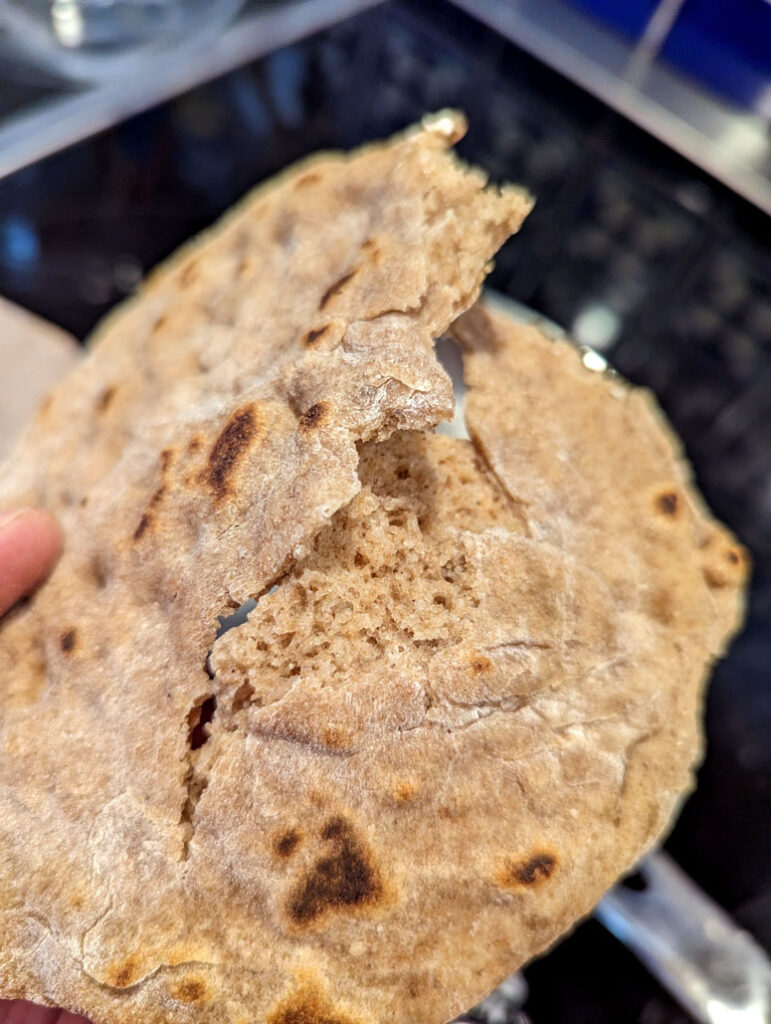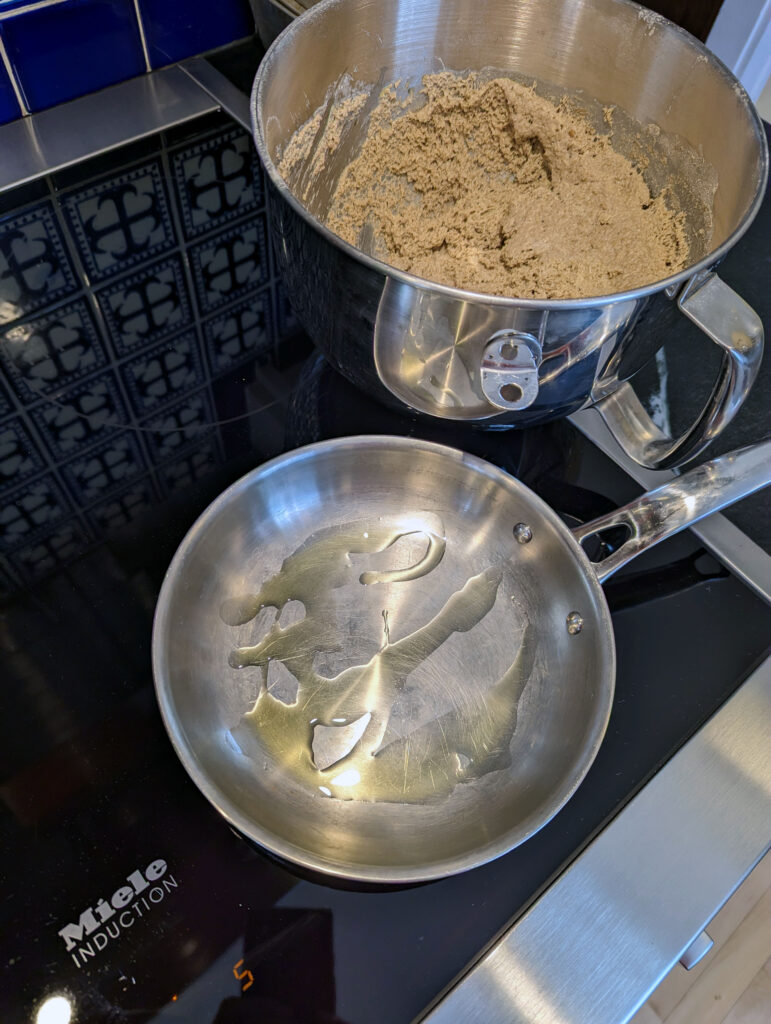Stovetop bread, on induction, electric, or gas — with a video!

Ingredients
1/4 pound dough (peach-size portion); click for white dough or whole wheat (as pictured below). You can also use gluten-free dough, but you’ll need to handle it differently
1 tablespoon oil, butter, or ghee
This amount of dough works well in a 10- to 12-inch skillet (what’s pictured below is in a smaller skillet that used about half as much dough). A heavy cast-iron skillet is traditional for this sort of thing, but good-quality stainless steel works nicely as well (if you’re using an induction stovetop, be sure to get compatible cookware, made from ferrous (iron-containing) metal. Some older stainless steel products won’t work with induction (almost all modern versions do). My Tramontina and All-Clad skillets both work great on this Miele stovetop (actually part of a range).
Dusting with flour, roll out the dough on a board or stretch with your fingers to create a 1/4-inch (6 mm) thick disc. Set aside while you preheat a 10- to 12-inch skillet with the oil, butter, or ghee on high heat (keep your eye on it and don’t let it smoke, but droplets of water should skitter when it’s ready to go).

For a richer, more “fried” effect, leave the oil in place as it heats up; for a leaner effect, wipe out most of the oil with a paper towel, as I did. Lower the heat to medium, drop in the disk of dough …

… and cover the skillet to trap steam and heat (no picture of the covered skillet!). Check for doneness at about 3 minutes, or sooner if you’re smelling scorched dough. Adjust the heat as needed, and flip the disk with a spatula when the underside is richly browned:

Continue for another 2 to 6 minutes, or until the bread feels firm, even at the edges, and the second side is browned. Adjust the heat if it’s browning too fast. If you’re going for a naan effect, brush with melted ghee when finished. These can be eaten slightly warm. Keep scrolling for a video of flatbread on a camping stove…

The method is very forgiving, and it works on any heat source, including a camping stove, with a bigger piece of dough for a thicker flatbread — see the video here:
Note: BreadIn5.com is reader supported. When you buy through links on the site, BreadIn5 LLC earns commissions.
Thank You Jeff,
Now I know of induction stove tops (new to me), and now I will try flat bread (sounds easy).
I am a long time follower of BI5 and do miss the continuing questions and answers
Alan
Great, let me know if you have any questions as you try this. Question for you though, when you say ” Miss the q&A”, I’ve been doing it all along. Are you finding that the q&A isn’t displaying on your interface?
I can’t wait to try this. When I take the appropriate amount of dough, is it right from the bucket that’s been in the refrigerator? Do I need to let it rest before shaping it?
Thank you!
No need, flatbreads are more forgiving this way, just go for it!
I saw you are using your recipe from New Bread in 5 book. Do you prefer this naan to the one in your Flatbread in 5 or was it more a matter of convenience?
It’s strictly a matter of convenience and preference. You can make a flat bread in a pan with pretty much any kind of dough from my books
As an experienced home baker, I think it is an important skill to be able to make bread without an oven. Flatbreads and skillet breads (such as oat farls) are a time-honored option in a number of cultures. At the beginning of the war in Ukraine, when seeing the devastated people trying to cook for themselves in the street after their homes were destroyed, made me wonder if bread could be made without baking. So I studied bread making alternatives from as many cultures as I could find such as Chinese, British, African, and early American. These people do (or did) not have ovens and learned to steam their breads. Steaming bread (most any recipe) has become a happy standard for me. Every new bread I try, I bake part of it and steam part of it to see which I prefer. They both have their advantages, both yeasted and quick types. Richer recipes are generally better baked, leaner ones, steamed. Mug cake recipes benefit from steaming too. A minute in the microwave just isn’t enough time to do justice to the ingredients. I started out using empty chicken cans for all these things. I like the process so well, I’ve invested in silicone baking cups. Bread is a major comfort food for much of the world. It’s worth learning to make the most of it.
interesting…